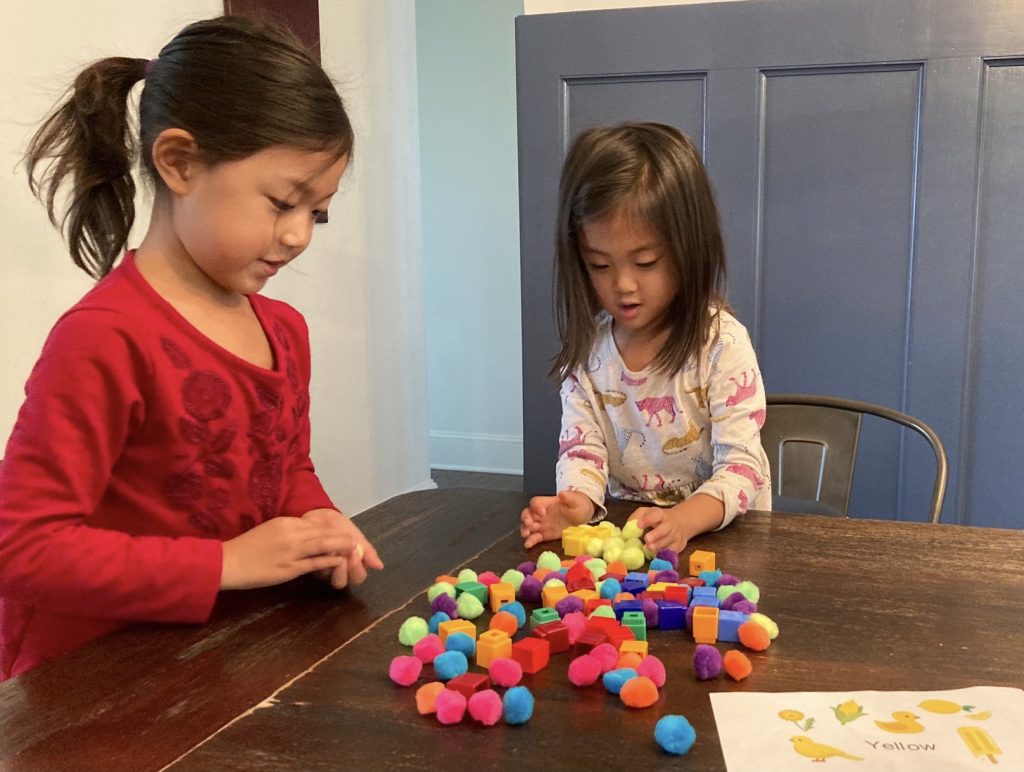1+
Moderate teacher engagement
Materials
- A collection of objects (for example, blocks, counters, toys, children’s shoes). Objects can be similar to or different from each other. Choose objects that can be sorted by more than one attribute, such as color, type, or shape. (Tip: Color is a good starting point because it is the easiest attribute for children to sort.)
- Sorting cards: One sorting card for each attribute you want children to use to sort the collection of objects. Use our free printables or create your own cards.
- Timer
Setup — Less than 5 minutes
- Choose a collection of sorting cards to use based on your collection of objects and the attributes you would like children to focus on (use the examples or create your own)
- Choose objects that can be sorted in more than one way. (TIP: You can begin with having children sort by color or type or shape. Color is the easiest attribute for children to sort by.)
- Set out a timer.
- Make sure that you have some objects in the collection that match each of the sorting cards.
Instructions
- Children draw a sorting card. Make sure children understand the sorting rule (for example, blue items and non-blue items).
- Using a timer of 1 minute or shorter, have children sort a collection of 10 objects by those that fit the sorting rule and those that do not (e.g., blue items vs. non-blue items) before the timer runs out. Use a longer timer if children need it.
- To play another round, children recombine the two sets of objects and draw another sorting card.

Checks for Understanding
To deepen children’s learning about early math concepts, talk and ask questions while doing this activity together. Here are some examples to get you started.
- “We’re looking for things that are green. What color is this block? Is that the same as or different from the color we’re looking for?”
- “What attributes do all the pictures on the card have in common? What is the same about them?”
- “Should this counting bear go in the set of red objects or non-red objects?”
- Before discussing the sorting rule: “If we use this sorting card, where would this block go? How do you know?”
- “Are there more things that are blue or not blue?”
Activity Modifications
Once you have tried out the activity, here are some other things you can do. Try these modifications to keep the activity interesting and challenging for children all year.
- Remove the timer entirely if children are still learning how to sort.
- Tell the children the sorting rule, rather than using the cards.
- Change the number of objects in the collection that need to be sorted.
- Offer a range of sand timers (for example, timers set to 30 seconds or 1, 3, or 5 minutes) and invite children to choose which timer to use.
- Add sorting rules that focus on other domains of math, such as shapes, numbers less than or greater than another number, or length.
- Have one child be the Sorter and one child be the Guesser. The Sorter secretly looks at the rule and starts Sorting. The Guesser has to guess the rule before time runs out.
- Have children come up with their own sorting rules.
- Sorting Groceries: Sorting Groceries – Sort play food. Before starting, elicit children’s stories about the grocery store or putting away groceries at home. Depending on children’s experiences or preferences, they can be grocery store workers or a family sorting groceries.
- Sorting Animals: Sort plastic animal toys by where we usually see them (land, water, air), or what they eat (carnivores vs herbivores).